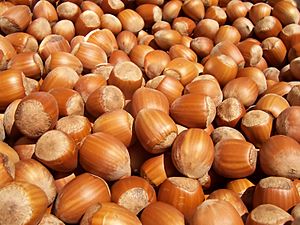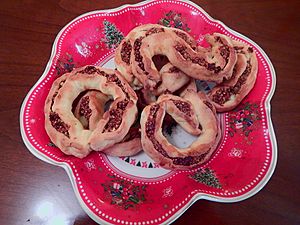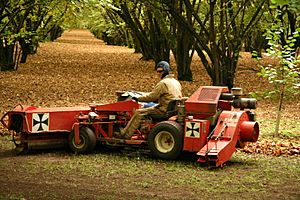Hazelnut facts for kids
Hazelnuts are tasty nuts that grow on hazel trees. They are sometimes called cob nuts or filbert nuts. Filbert nuts are a bit longer and thinner than regular hazelnuts. These nuts naturally fall from their husks when they are fully ripe. This usually happens about seven to eight months after the flowers are pollinated. Hazelnuts are often used as food for farm animals or ground into a smooth paste. Major places that grow hazelnuts include Greece, Turkey, Italy, and the American states of Washington and Oregon. Hazelnuts are also very popular with chocolate, especially in chocolate truffles. Plus, hazelnuts are good for you because they are rich in proteins and healthy unsaturated fats.
Contents
Delicious Ways to Use Hazelnuts
You might know hazelnuts from some famous treats! The company Ferrero SpA, which makes Nutella and Ferrero Rocher, uses a huge amount of the world's hazelnuts. About 25% of all hazelnuts grown go to this company!
Hazelnuts are used in many different sweets and treats. They are found in pralines, chocolate truffles, and various hazelnut paste products. In Austria, hazelnut paste is a key ingredient for making special cakes called torte, like the Viennese hazelnut torte.
In Kiev cake, a type of cake, hazelnut flour is used to give flavor to its fluffy meringue layers. Crushed hazelnuts are also sprinkled on the sides. Another French dessert cake called Dacquoise often has a layer of hazelnut meringue. Hazelnuts are also popular in Turkish cuisine and Georgian cuisine. For example, the snack churchkhela and the sauce satsivi often use hazelnuts, sometimes mixed with walnuts. You can eat hazelnuts fresh or dried, and they taste a little different depending on how they are prepared.
How Hazelnuts Are Harvested
Hazelnuts are picked once a year in the middle of autumn. As autumn ends, the hazelnut trees drop their nuts and leaves. Most large farms wait for the nuts to fall naturally, instead of shaking them off the trees. Hazelnuts are collected either by hand or by using tools to rake the fallen nuts.
Farmers use a few main machines to harvest hazelnuts: a sweeper, a harvester, a nut cart, and a forklift. The sweeper gathers the nuts into neat rows. The harvester then picks up the nuts and separates them from leaves and twigs. The nut cart holds the nuts collected by the harvester. Finally, the forklift moves the full nut carts and stacks them, ready to be sent to a processing plant where they are dried.
The sweeper is a low machine that drives through each row of trees twice. It has a belt at the front that spins to sweep leaves, nuts, and small twigs from one side to the center of the row. At the back, a strong blower pushes any remaining material into the next row. This careful sweeping helps make sure most nuts are in the middle of the row, ready for the harvester. It's best to sweep only a few rows at a time, so the harvester doesn't crush nuts that are still falling from the trees. Hazelnut farms might be harvested up to three times during the season, depending on how many nuts fall and the weather.
The harvester is a slow machine pulled by a tractor. It lifts the material off the ground and separates the nuts from leaves, empty husks, and twigs. As it moves over the rows, a spinning part with many prongs rakes the material onto a belt. This belt carries the material over a blower and under a strong vacuum. The vacuum sucks up light dirt and leaves, blowing them back into the orchard. The clean nuts then go into a nut cart pulled behind the harvester. When a cart is full, a forklift takes it away and brings an empty one, so the harvester can keep working without stopping.
Farmers have different ways of deciding when to collect the fallen nuts. One way is to harvest early, when about half of the nuts have fallen. With less material on the ground, the harvester can work faster. Another way is to wait until all the nuts have fallen before harvesting. While harvesting early might seem better, it means doing two or three passes instead of just one. Weather is also important. Rain can make harvesting difficult, so waiting until after a rainy period might make it harder to pick up the nuts. The best timing also depends on the size of the farm and how many machines are available.
Where Hazelnuts Are Produced
In 2016, the world produced about 743,455 tonnes of hazelnuts (still in their shells). This was a bit less than in 2015. Turkey grew the most hazelnuts, producing 57% of the world's total. Other big producers included Italy, the United States, Azerbaijan, and Georgia.
In the United States, almost all hazelnuts (99%) came from Oregon in 2014. The hazelnuts grown there were worth about $129 million and were mostly bought by companies that make snack foods.
Images for kids
See also
 In Spanish: Avellana para niños
In Spanish: Avellana para niños







